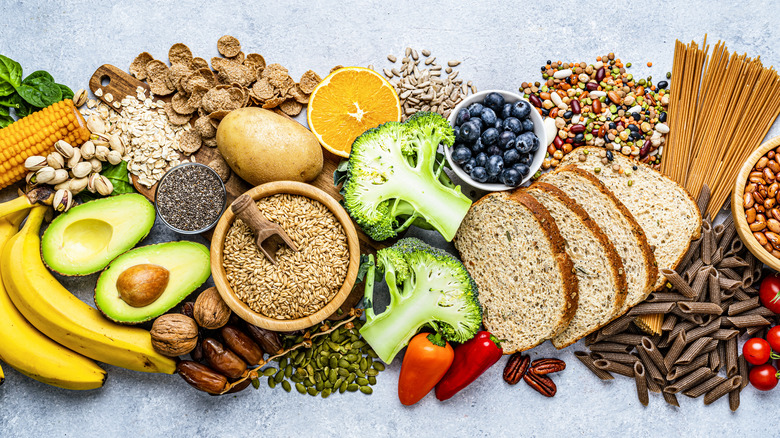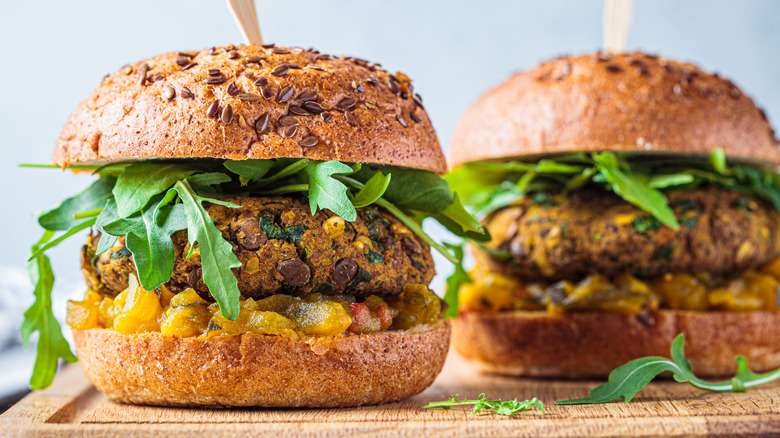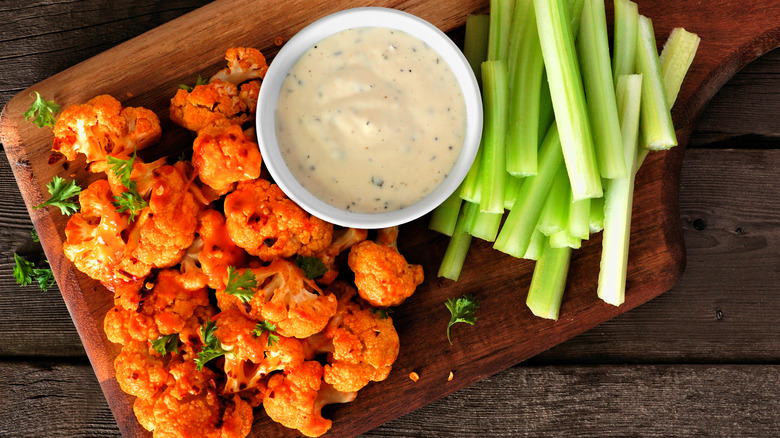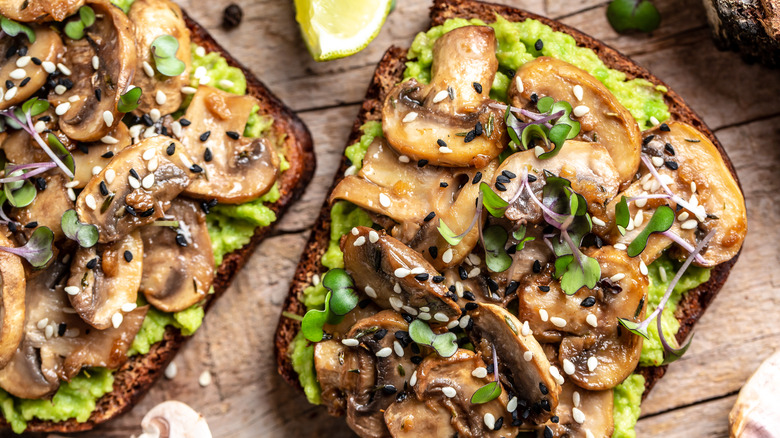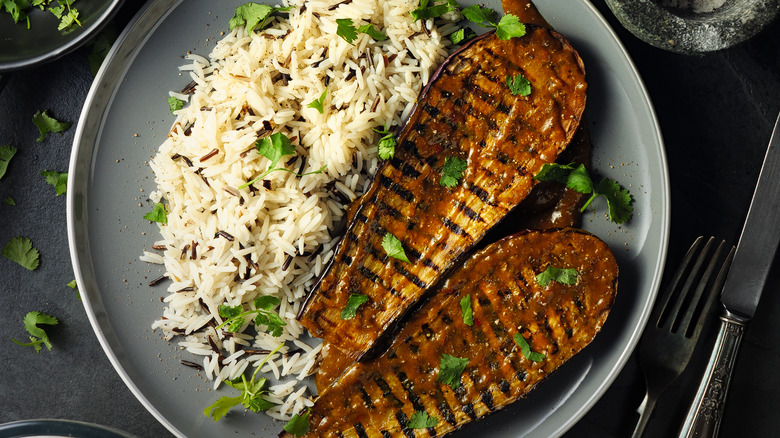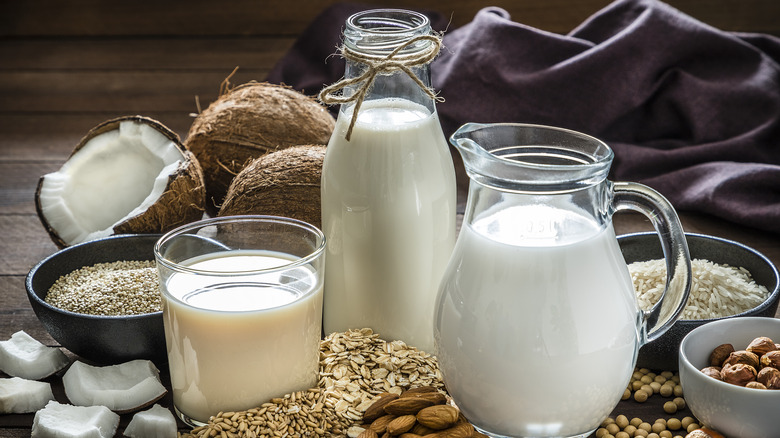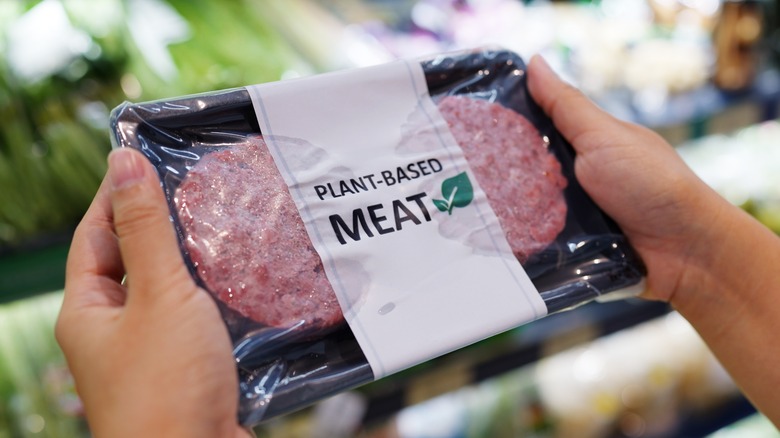12 Plant-Based Cooking Tips You Need To Know, According To Spike Mendelsohn - Exclusive
There is no shortage of reasons why plant-based diets are an increasingly popular lifestyle choice for Americans. From the environmental considerations and the proven health benefits, not to mention the economic factors, it's no surprise that more and more people are embracing eating habits that put meat and animal-based foods on the back-burner.
Most would agree that there's really no downside to plant-based eating –- but it's plant-based cooking that tends to throw people off. Preparing a meal where veggies are the star of the show can be tough for folks who are used to seasoned steaks and marinated chicken, with fresh produce as the supporting elements in a well-balanced meal. However, plant-based cooking can be more delicious and simple than you might think if you're equipped with the right tips and techniques to let your vegetables shine to their full potential.
For your ultimate guide to plant-based cooking, we spoke with chef, restaurant owner, and "Top Chef" competitor Spike Mendelsohn. As the co-founder of Eat the Change, he's a champion of plant-based eating and on a mission to show just how fulfilling and flavorful this lifestyle can be. "I love what it does for the planet and the environment, and I love what it does for our health ... and the amount of innovation that the plant-based space has had is incredible here in the last five years," he tells Tasting Table. Read on for his essential cooking tips to inspire your next (or first!) plant-based meal.
1. Don't fall for the plant-based myths from the start
Before you even start chopping and firing up the stove, start your plant-based cooking journey by getting in the right mindset. That begins with letting go of the biggest myths and preconceived notions about a vegetable-forward menu and what it's going to taste like. "One massive misconception about plant-based eating is that it can't be delicious," says Mendelsohn. "The other is you can't take traditional foods that people really love and know and are familiar with and turn them into plant-based dishes." If you go beyond your basic steaming and roasting and learn to play around with seasonings and ingredients, you'll be surprised with the wide-ranging potential of your plant-based meals.
The other major misconception that Mendelsohn says holds a lot of people back is the idea that plant-based alternatives for animal products aren't natural. He points to "a lot of meat companies [that] are coming down and saying that plant-based foods are unhealthy." But the chef insists that "plant-based food doesn't mean just processed foods," adding that we're starting to experience "a massive shift in our food sourcing and production." The result of that is a range of new plant-based food items made with high-quality, clean ingredients.
2. Rethink your protein
For some people, especially those with particularly active lifestyles, a big obstacle to embracing plant-based eating is the idea that you can't get an adequate amount of protein. However, Mendelsohn insists that's not the case, and you have more options than you think. He says that plant-based meat alternatives like Beyond Meat have plenty of protein –- the Beyond Burger, for instance, has 20 grams of protein per serving. He also points to his restaurant Plnt Burger, which offers fried chicken sandwich alternatives made from mushroom roots which pack a whopping 29 grams of protein.
But it's also important to note that you don't need to rely on meat substitutes to meet your protein needs outside of animal products. "You can find protein in legumes, beans ... many different places other than animal meat," Mendelsohn says. Nuts, whole grains like quinoa and oats, hemp and pumpkin seeds, chickpeas, and even broccoli and green peas are all excellent sources of plant-based protein.
3. Burgers, pizzas, and tacos are great starter recipes
Maybe you want to embrace plant-based cooking, but you're not ready to give up your favorite traditionally meat-centric dishes. In that case, start by making swaps with ingredients for the dishes you already love. According to Mendelsohn, the key to a plant-based transition is really about "meeting people where they're at with some of their comfort foods."
He suggests starting with relatively easy-to-prepare standard dishes. "I think you could always get excited behind a burger," he says, "so that's by far the easiest swap." Or, for your next taco Tuesday, try a "plant-based crumble meat that is hitting the market, whether it's flavored with chorizo seasonings." The same goes for a pizza –- and there are plenty of tasty plant-based cheeses on the market if you really want to go all the way. "And then just start to incorporate more vegetables," adds Mendelsohn.
4. Asian-inspired recipes lend themselves well to plant-based cooking
While you can always find ways to make delicious plant-based swaps to your favorite recipes from any cuisine, it may also be simpler to lean into those that naturally lend themselves to plant-based dishes. Specifically, many Asian culinary styles already heavily utilize vegetables as main courses. For example, "Indian cuisine, a lot of it is vegetable cooking," says Mendelsohn. In India, vegetarian cooking is standard across the board, based on the religious values of much of the population. Thus, many of the incredibly flavorful, super-spiced traditional dishes feature potatoes, tomatoes, eggplant, okra, and more.
Additionally, "Vietnamese cuisine has a good degree of vegetable-forward [dishes]," says Mendelsohn. But whether you prefer Thai, Chinese, Japanese dishes, or otherwise, the key is that many of these cuisines are built around dishes like soups, stews, and noodle bowls, which have a base structure and seasoning backbone that doesn't rely on meat, making them super easy to make plant-based swaps.
5. Cauliflower is your ultimate plant-based chicken swap
Cauliflower has been having a moment in the spotlight for its flavor and texture versatility, whether it's used as a stand-in for rice, mashed potatoes, or pizza crust. For Mendelsohn, it's one of his favorite plant-based substitutes when it comes to a familiar favorite. "I use cauliflower to kind of mimic fried chicken ... It's a very comforting food, and I've been able to really recreate it to the T," he says.
Mendelsohn starts by cutting his cauliflower heads into eighths, leaving the stem intact. Next, the chef says he will "season them with salt, pepper, olive oil, and I'll put 'em on a sheet tray rack and I'll roast them in the oven." This step is the key to achieving the chicken-like texture you desire. "Probably one of the most important steps of the cauliflower chicken is you don't want to roast them where they're completely cooked, but you don't want to leave them too raw," he adds.
Once you've cooked the veggie to perfection, it's time to bread the filets using vegan egg yolk followed by flour, dipping until you get a thick, clumpy coating. According to Mendelsohn, this ensures maximum crunch To finish off, he recommends some chilling time in the fridge before you drop those morsels into your frying pan or deep fryer. "They come out just [like] fried chicken ... and they're just delicious," he notes.
6. Mushrooms are plant-based cooking heroes
When in doubt, mushrooms are a fantastic ingredient that can stand up to a range of ingredients, spices, and cooking techniques to help your plant-based dishes sing. Big portobellos make great burger stand-ins, chopped shiitakes are a hit on tacos, and nachos, and baby bellas deliver great umami in a plant-based gravy.
You can also use mushrooms to make the ultimate road trip and picnic snack: jerky. Mendelsohn creates his own, non-processed mushroom jerky using portobellos, which he says "have been the swap for meat eaters for the longest time." Mendelsohn goes all out, marinating and smoking the mushrooms with hickory and wood chips "in the traditional style of making jerky." While many turn to liquid smoke as a shortcut, Mendelsohn says you're going to have a tastier, more meaty-like experience with "real authentic flavor" if you do it right and don't "sacrifice the artisanal part of making jerky."
7. Eggplant is a great entrée ... if you cook it correctly
Another go-to veggie for plant-based entrees is eggplant. It holds its integrity on the grill, in the oven, or in a sauté pan, and it is great at absorbing whatever flavor you add to it. However, when trying to make eggplant the star of the show, there are some important cooking considerations. "The single most important thing when you are cooking eggplant is you have to soak it in water and salted water," Mendelsohn says. There are a few reasons for that. "One, there's a lot of seeds in eggplant that impart a bitter taste. So the salt soaking and salt will extract the bitterness out of the seeds." He adds that since it acts like a sponge, "soaking in water helps the texture and keeps the true flavor of the eggplant."
If you skip this step, and immediately coat your eggplant in cooking oil and throw it on a hot pan, you'll soon regret it. Within the blink of an eye, you're going to be left wondering where all that fat went, and why your eggplant is dry and starting to burn. The water soak acts as a sort of shield. That way, according to Mendelsohn, "you're not just getting a mouthful of oil, you're actually getting eggplant in there."
8. Use canned jackfruit for easy vegan barbecue
Backyard barbecues and summer cookouts can seem like a challenge for plant-based eaters, but there's a game-changing ingredient that may just have you reconsidering: jackfruit. This tropical tree fruit has a subtle sweetness and a stringy texture, and it makes for the perfect pulled pork alternative — with much less time and effort. "Jackfruit is a very versatile ingredient. It soaks up a lot of sauce and liquid or marination and it cooks fairly easily," says Mendelsohn. Plus, it even looks like pulled pork when it's all said and done.
There are two important things to keep in mind. Your best bet "would be finding some canned organic canned jackfruit because it's probably the easiest to start with instead of buying the fresh stuff," Mendelsohn suggests. If you are using canned jackfruit, he insists that "you want to make sure you rinse it before using it," for more pure flavor. From there, "just the way you would season your pork, or all the same spices, you just add that to the jackfruit and cook it down and sauté it and it just reacts really well."
For some added inspiration, Mendelsohn says he also loves to use jackfruit for plant-based crab cakes in the summer months. He mixes it with lion's mane mushrooms, and a combo of scallions, shallots, and spices. His advice: "Make your patties and you form them up and then bread them and fry them," just like you would a regular crab cake.
9. Match your dairy alternative to your recipe
Perhaps one of the earliest plant-based swaps to really take hold in modern vegan and non-vegan kitchens alike was milk alternatives. Today you can find a range of plant-based milk made from nuts, seeds, oats, rice, coconut, and more. And while any and all of these can be incorporated into your recipes in place of dairy milk, learning to match your milk to your plant-based recipe of choice will mean optimal flavor in all your dishes.
Take mashed potatoes: A subtly sweet and slightly watery almond milk might not aid the creamy, salty, buttery taste you're hoping for, but Mendelsohn says, in the case of this dish, there are "some really fabulous plant-based creams and plant-based butter is really on point." When it comes to plant-based pasta, he notes, "I'm not adding oat milk to my pasta dish. It's an oat flavor. It's a little off, but there's this aquafaba cream that hit the market that's really good."
At the end of the day, the chef says, "Sometimes you have to work a little harder to find the ingredients, but they're out there and they're working." Take the time to find what's available to you, and enjoy the fun of testing out varieties of plant-based milk with different recipes until you create the creamy dishes your heart desires.
10. Plant-based egg substitutes work as well as the real thing
Eggs may appear to be a tricky ingredient to substitute in plant-based cooking. But that's really not the case thanks to the plethora of vegan egg alternatives you can now find at the grocery store. Chef Mendelsohn recommends the plant-based options from JUST Egg, specifically, noting that "it's a really good product." The company, which makes its egg substitute from mung bean, now offers a scrambled variety, a folded egg product perfect for breakfast sandwiches and omelets, and a sous vide mix that is ideal for egg bites.
Outside of breakfast, eggs are also an important baking ingredient. Luckily, Mendelsohn says "there's a lot of swaps happening in the baking category" for plant-based eaters who still want to enjoy their favorites like chocolate chip cookies, fudgy brownies, and moist spongy cakes. In those cases, aquafaba, the liquid leftover from chickpeas, is your best friend. Add it as is to recipes that list whole eggs or whip to create magically airy textures in recipes that call for beaten egg whites.
11. Be discerning when choosing a plant-based meat alternative
These days, you'll have no problem finding plenty of options at the grocery store for plant-based meat. But that doesn't mean all those items are created equal. If you want to make the most of your plant-based dishes, ensuring you get the best flavor and most health benefits, then you need to shop with a watchful eye. Mendelsohn says you want to choose a plant-based meat "that has a reputable source so that the ingredients are being sourced properly," adding that it's always better to buy organic when possible, "but above all, I think you should stay away from the GMO ... or a lot of the stuff that has soy in it."
Mendelsohn particularly loves Beyond Meat products. "It's an evolution when you start a product and you have to get the cleaner labels," he says. "And one thing I know for sure is Beyond Meat, it's been doing the work ... so immediately it's addressing the concerns of a lot of the people."
12. Get kids involved to make plant-based eating more fun
Equipped with the right ingredients and cooking tips, plant-based eating can be simple, delicious, and enjoyable for any adult. But getting kids on board is a whole other kind of challenge. As a parent himself, Mendelsohn is familiar with the ups and downs of getting kids excited about vegetables. "Things could seem a little foreign for kids if they're not part of the household from the get-go," he says, "but if you get these things really early on [they] just become rudimentary and familiar."
On top of that, Mendelsohn adds, "to get these ingredients more familiar in the household, where your kids feel a little less awkward ... it's just getting their hands on them." For example, he suggests "whenever we're cooking with broccoli, for instance, or cauliflower or mushrooms, those vegetables are really fun to fabricate, get your hands on, they look funny, they're like trees ... the stems kind of pop out of mushrooms in a funny little way that makes a little sound."
One thing Mendelsohn insists you shouldn't do is to trick kids into eating vegetables. "It's very short term," he warns, and may end up backfiring when children grow up and start making their own food choices. Instead, "make it a little playful and you'll be surprised at the information they retain and how much fun they have with it."

